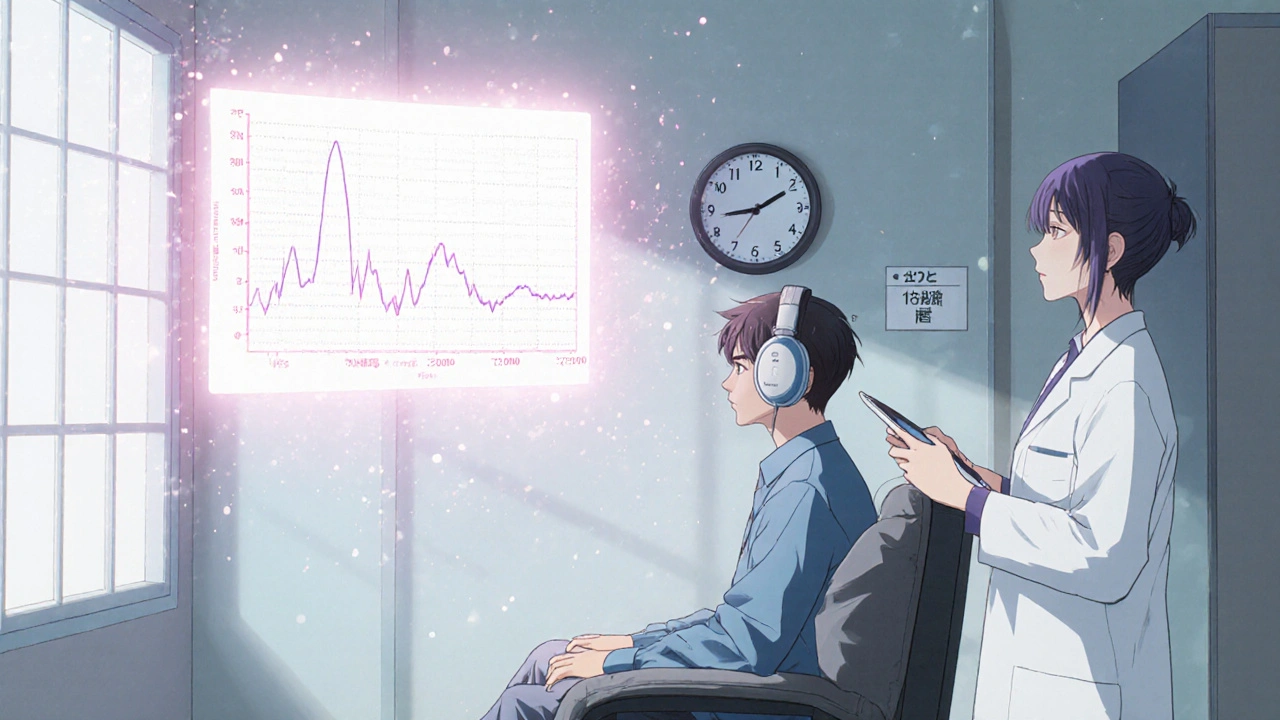Every year, 22 million American workers are exposed to dangerous noise levels on the job. Many won’t notice the damage until it’s too late-permanent hearing loss creeps in slowly, silently, and without pain. This isn’t just a health issue. It’s a legal requirement, a financial risk, and a preventable tragedy. Hearing Conservation Programs (HCPs) exist to stop this before it starts. But if your workplace isn’t doing them right, you’re not just breaking the law-you’re putting people’s futures at risk.
When Does a Hearing Conservation Program Become Mandatory?
It’s not about how loud it sounds. It’s about numbers. If employees are exposed to noise at or above an 8-hour time-weighted average of 85 decibels (dBA), your company is legally required to have a full Hearing Conservation Program under OSHA’s 29 CFR 1910.95. That’s the action level. It’s not a suggestion. It’s the line you can’t cross without consequences.
Think of it this way: a busy factory floor, a printing press, a construction site with jackhammers, or even a busy call center with constant background noise can all hit that threshold. You don’t need to hear ringing in your ears to be in danger. The damage builds up over years. One day, you realize you’re asking people to repeat themselves. By then, it’s permanent.
OSHA doesn’t wait for complaints. They inspect. And in 2022 alone, they issued 1,842 citations for hearing conservation violations. Penalties range from $15,625 to over $156,000 per violation. That’s not a fine. That’s a wake-up call.
The Five Core Requirements of a Legal HCP
A compliant Hearing Conservation Program isn’t optional. It’s built on five non-negotiable pillars. Skip one, and you’re out of compliance.
- Noise Monitoring - You can’t protect what you don’t measure. Employers must use calibrated sound level meters or noise dosimeters to identify areas where noise hits 85 dBA or higher. This isn’t a one-time check. Every time you change equipment, add machinery, or reconfigure a workspace, you must retest. If you’re not tracking exposure changes, you’re flying blind.
- Audiometric Testing - This is the early warning system. Every employee exposed to 85 dBA or more must get a baseline audiogram within six months of starting their job. They must be out of noisy environments for at least 14 hours before the test. After that, they get an annual test. The frequencies tested? At minimum: 500, 1000, 2000, and 3000 Hz. The room must meet strict background noise standards (OSHA Appendix C). The audiometer? Must meet ANSI SC-1969 specs. (Note: OSHA is pushing to update this to ANSI S3.6-2018 by late 2024.)
- Hearing Protection - Earplugs and earmuffs aren’t just tools-they’re life-saving equipment. Employers must provide a variety of options and train workers on how to use them correctly. The goal? Reduce exposure to at least 90 dBA over eight hours. But here’s the catch: many workers wear them wrong. A poorly fitted earplug can cut protection in half. That’s why fit testing is critical-and why 52% of safety managers say it’s one of their biggest challenges.
- Training - Annual training isn’t a formality. It’s the difference between compliance and catastrophe. Employees need to understand: how noise damages hearing, why hearing protection matters, how to insert earplugs properly, and what audiometric tests are for. If your training is a 10-minute video played in the break room, you’re not doing it right. Real training answers questions. It shows videos. It lets people try different protectors. It makes them care.
- Recordkeeping - You must keep noise exposure records for at least two years. Audiometric test results? You keep them for the entire time the employee works for you. If they leave and come back five years later, you still need their old data. No excuses. No digital gaps. Paper or digital-it must be there.
What Happens When Hearing Loss Is Detected?
Audiometric testing isn’t just about collecting data. It’s about reacting. If an employee shows a Standard Threshold Shift (STS)-a 10 dB or greater average drop at 2000, 3000, and 4000 Hz compared to their baseline-you have 30 days to act.
Here’s what you must do:
- Notify the employee in writing within 21 days.
- Re-fit their hearing protection and retrain them on proper use.
- If their current protectors aren’t enough, provide ones with higher noise reduction ratings (NRR).
- Refer them for a clinical audiological evaluation if there’s any sign of medical issues like ear infections or tumors.
And here’s something many employers miss: you can revise the baseline audiogram-if a professional supervisor confirms the shift is real and persistent. That prevents the same person from being flagged year after year for the same shift. But you can’t just ignore it. That’s not just bad practice. It’s a violation.

The Hidden Costs of Doing Nothing
Some companies think HCPs are expensive. They’re wrong. The real cost is in what you lose when you skip them.
Studies show workplaces with strong programs see 5-10% higher productivity and 15-20% fewer absences. Why? Because workers aren’t struggling to hear instructions. They’re not missing alarms. They’re not stressed out by constant noise. They’re safer. They’re more focused.
On the flip side, untreated noise-induced hearing loss (NIHL) leads to social isolation, depression, and increased risk of accidents. The American Academy of Audiology says even at 85 dBA, 8-12% of workers still lose hearing over a lifetime. That’s not rare. That’s expected if you don’t act.
And the financial hit? The market for hearing conservation services is worth $1.5 billion a year. That’s because companies are paying for it-either through compliance, lawsuits, or workers’ compensation claims. A comprehensive HCP costs $250-$400 per employee annually. Audiometric testing makes up nearly half of that. But compared to a $150,000 OSHA fine? Or a $200,000 workers’ comp claim? It’s a bargain.
Why So Many Programs Fail
OSHA’s 2022 enforcement report found that 62% of violations were due to faulty audiometric testing. 28% were because training was inadequate. These aren’t edge cases. These are systemic failures.
Small businesses suffer the most. With fewer than 50 employees, 37% are non-compliant-nearly double the rate of larger companies. Why? Lack of time, lack of resources, lack of knowledge. But here’s the fix: mobile audiometric testing units. Companies using them report a 60% reduction in employee downtime. No more sending workers to clinics. No more lost shifts. A technician comes to you. Tests are done on-site. Results are instant.
Another problem? Employee participation. In a 2023 SHRM survey, 68% of safety managers said workers skip audiometric tests. Why? They think they’re fine. They don’t feel anything. They don’t see the point. That’s why training must be ongoing, engaging, and personal. Show them their own test results. Explain what the numbers mean. Make it real.

What’s Changing in 2025?
OSHA isn’t standing still. In late 2024, new rules are expected to take effect:
- Audiometers must meet the updated ANSI S3.6-2018 standard, not the outdated 1969 version.
- Test frequencies will expand to include 4000 Hz and 6000 Hz-critical for detecting early high-frequency hearing loss.
- Employers will need to provide hearing protectors with higher NRR ratings for exposures above 100 dBA, not just aim for 90 dBA.
These changes will raise costs by 8-12%. But they’ll also prevent an estimated 150,000 new cases of hearing loss every year. That’s not just compliance. That’s responsibility.
Right now, only 58% of manufacturing plants and 42% of construction sites fully comply. That’s not good enough. The science is clear. The law is clear. The tools are available. The only thing missing is action.
What You Should Do Today
If you’re responsible for workplace safety:
- Identify all areas where noise hits 85 dBA or higher. Use a calibrated dosimeter. Don’t guess.
- Start audiometric testing for everyone exposed. Baseline within six months. Annual tests after that.
- Provide at least three types of hearing protection: foam plugs, silicone plugs, and earmuffs. Train workers on how to fit them.
- Hold real training-not a PowerPoint. Let people try the protectors. Show them real test results.
- Keep digital or paper records. Store them forever for active employees.
- Watch for STS. Act within 30 days. Don’t wait.
- Consider a mobile testing service. It’s cheaper than fines. And it gets better participation.
Hearing loss doesn’t happen overnight. But it doesn’t happen without warning either. Your program isn’t just about following rules. It’s about protecting the people who keep your business running. Don’t wait until someone can’t hear their grandchild’s voice. Start today.
What noise level triggers a Hearing Conservation Program?
A Hearing Conservation Program is required when employees are exposed to noise at or above an 8-hour time-weighted average of 85 decibels (dBA). This is called the OSHA action level. Even if workers don’t feel the noise is loud, if the measurement hits 85 dBA, you must implement the full program including monitoring, testing, protection, training, and recordkeeping.
How often must audiometric testing be done?
Employees exposed to 85 dBA or higher must get a baseline audiogram within six months of starting their job. After that, they must receive an annual audiogram every year. The test must be conducted in a quiet room, using a calibrated audiometer, and the employee must be free from workplace noise for at least 14 hours before the test.
What is a Standard Threshold Shift (STS)?
A Standard Threshold Shift (STS) is a measurable decline in hearing ability-specifically, an average change of 10 dB or more at 2000, 3000, and 4000 Hz compared to the employee’s baseline audiogram. When an STS is detected, employers must notify the employee in writing within 21 days, retrain them on hearing protection, provide better protectors if needed, and refer them for a clinical evaluation if there’s any sign of a medical condition.
Can employers use any type of earplug or earmuff?
No. Employers must provide a variety of hearing protection options, including earplugs and earmuffs, so employees can choose what fits best. The protection must reduce noise exposure to at least 90 dBA over eight hours. Employers must also train workers on how to insert earplugs correctly, since improper use can reduce protection by up to 50%. Fit testing is strongly recommended to ensure effectiveness.
What happens if a company doesn’t have a Hearing Conservation Program?
OSHA can issue citations with fines ranging from $15,625 to $156,259 per violation. In 2022, over 1,800 citations were issued for hearing conservation failures. Beyond fines, companies face higher workers’ compensation claims, increased absenteeism, lower productivity, and potential lawsuits from employees who develop permanent hearing loss. Non-compliance also damages safety culture and employee trust.
Are small businesses exempt from Hearing Conservation Programs?
No. OSHA regulations apply to all employers regardless of size. However, small businesses with fewer than 50 employees have a 37% non-compliance rate-nearly double that of larger companies-due to limited resources and awareness. Mobile audiometric testing services and free OSHA training materials can help small businesses meet requirements without high costs.
How long must audiometric records be kept?
Audiometric test results must be kept for the entire duration of the employee’s employment. Even if the employee leaves and returns years later, their past test records must still be available. Noise exposure monitoring records must be kept for at least two years. Digital storage is acceptable as long as records are secure, accessible, and backed up.
Will OSHA update its hearing protection standards in 2025?
Yes. New rules expected in 2025 will require audiometers to meet the updated ANSI S3.6-2018 calibration standard, expand test frequencies to include 4000 Hz and 6000 Hz, and require higher noise reduction ratings (NRR) for exposures above 100 dBA. These changes aim to detect hearing loss earlier and provide better protection. While costs will rise slightly, they’re projected to prevent 150,000 new cases of occupational hearing loss annually.

